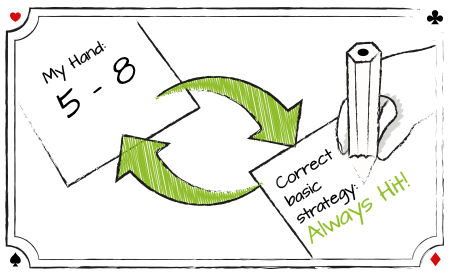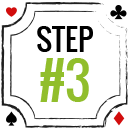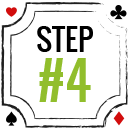
HOW TO PRACTICE BLACKJACK STRATEGY

- Give you tips on how to learn the basic playing strategy presented in Chapter 3.
- Show you how to recall the correct playing decision in a logical manner in a casino environment.

ORDER OF THE DECISION-MAKING PROCESS
As you saw in Chapter 3, I presented the basic strategy for different
sets of rules and number of decks in a color-coded chart.
I know that some players find it difficult to memorize the strategy using the chart, which is why I also presented the same strategy as a set of rules that most players find easier to understand and learn. But to make your task of memorizing the strategy even easier, I’ve summarized a few ways that you can try to make it easier to learn the strategy.

ago. It worked for me then and it’ll work for you today.
 Purchase a pack of index cards. Go to one of the tables in Chapter 3 that corresponds to rules and the number of decks for the game that you most likely will be playing in a casino, let’s suppose Double Deck with S17 and DAS. On the first index card, write on one side your hand, first line of the strategy table. This would be “5-8.” On the other side of the index card, write down the correct basic strategy, in this case it would be “Always Hit”. Continue this process of writing each line of the strategy table on an index card, always writing your hand on one side and the correct strategy on the other side. When you are done, you will have a pack of 29 flash cards that you can use to memorize the basic strategy.
Purchase a pack of index cards. Go to one of the tables in Chapter 3 that corresponds to rules and the number of decks for the game that you most likely will be playing in a casino, let’s suppose Double Deck with S17 and DAS. On the first index card, write on one side your hand, first line of the strategy table. This would be “5-8.” On the other side of the index card, write down the correct basic strategy, in this case it would be “Always Hit”. Continue this process of writing each line of the strategy table on an index card, always writing your hand on one side and the correct strategy on the other side. When you are done, you will have a pack of 29 flash cards that you can use to memorize the basic strategy.
Spend about 10-15 minutes a day going through your flash cards. Look at the side that has “your hand.” Recite what you think is the correct basic strategy, then turn the card over to check if you got it right. Set aside the cards where you didn’t get the strategy correct. After you go through your entire pack of flashcards, take the cards where you made mistakes and run through them again. Keep doing this exercise every day until you are able to recall from memory the correct playing strategy for each hand. If you have a spouse or friend who can help you with this drill, it will be even easier.
When you can consistently go through your flash cards without any errors, you are ready for the next drill.


 REPRODUCE THE BLACKJACK STRATEGY CHART
REPRODUCE THE BLACKJACK STRATEGY CHART
At the end of this chapter you’ll find a blank strategy chart that lists only the dealer’s upcard and your hands, everything else is blank. Make copies of the table or create a blank table yourself, and then fill in the correct strategy for every hand from memory. Compare the strategy table that you created with the strategy table in Chapter 3. Your goal is to be able to accurately reproduce the basic strategy table from memory. Tip: Just fill in one section of the table, e.g., “hard hands”, the first day, the “soft hands” section the next day, and the “pairs” section the following day. This will make this task appear less onerous.
When you can consistently go through your flash cards
without any errors, you are ready for the next drill.

 BLACKJACK PRACTICE WITH A DECK OF CARDS
BLACKJACK PRACTICE WITH A DECK OF CARDS
Next, take a deck of cards and place a 2 face up on the table. Deal yourself two cards face up and from memory decide how you would play the hand against the dealer’s 2 upcard. Check the strategy chart or table to be sure you got it right. Keep repeating this process with another two cards until you’ve run through the deck of cards. Next reshuffle the deck of cards, place a dealer’s 3 on the table, and deal yourself two cards face up. Say how you would play the hand then check the strategy chart or table to be sure you got it right. Continue this process, changing the dealer’s upcard to 4, 5, 6, etc., for all ten dealer’s upcards. Your goal is to get every hand right. Note: Having a partner deal you the cards would be helpful.
You can try this drill for soft hands and pairs, only this time place the soft hand (or pair) on the table (e.g., A-2 or 2-2) and then run through the deck flipping one card at a time and assume that’s the dealer’s upcard. For example, you place an A-2 on the table (your hand) and flip over a 2. The correct strategy for a Double- Deck, S17, DAS game is hit. You repeat this process for all the soft hands and pair splits.

USING YOUR COMPUTER OR SMART PHONE
I’m going to plug the software that I use when I teach students basic strategy in my blackjack classes. It’s called Blackjack Mentor and it’s available for Android and iPhone smart phones, Microsoft Windows for PC’s, and Palm OS/Pocker PC’s. Here are a few examples of how this program can help you learn the basic strategy.
The program’s “Drill Mode” allows random blackjack hands to be displayed, and you have to pick the correct play. The program remembers which ones you get right or wrong, and tends to pick the ones you are having the most problems with. You can also select specific hands to be tested on, and view your error statistics from Drill Mode.
The “Memorize Mode” displays a blank strategy table and allows you to fill in the correct play one cell at a time, just like the drill I mentioned earlier using paper and pencil. The software will alert you if you input an incorrect play and marks the error. The software has over 100 built-in tables ready to be used with a wide range of blackjack rules and number of decks.



BLANK STRATEGY CHART:

PRACTICE BLACKJACK STRATEGY
the heat of the battle when they are playing blackjack in a casino.
Sometimes it’s also experienced players that become perplexed.
For example has this ever happened to you? You make your bet and the dealer gives you a pair of 9s. You glance at the dealer’s upcard and it’s a 9. Before you know it, the dealer is pointing in your direction waiting for a signal from you. You've reviewed the basic playing strategy a hundred times at home but now your mind draws a blank and you left your strategy card at home to boot. Your fellow players start to get impatient as you stare at your hand trying to remember whether or not you should stand on 18 or split the 9s. Frustrated, you reluctantly wave your hand over your cards, indicating to the dealer you want to stand on the pair of 9s, which by the way is not the right play —splitting is.
It's one thing to memorize the basic strategy at home but quite another to recall it during the excitement in a casino.
However, whether you are a new or experienced player, I’ve got a simple process that you can follow that will help
you remember the right playing decision.


ASSUMING THE CASINO RULES ALLOW SURRENDER
Surrender takes priority over all the other playing decisions, so the first question to ask yourself is should I surrender? You should know by now that the hands you would consider surrendering occur when the dealer’s upcard is either a 9, 10, or A. Therefore, look at the dealer’s upcard. If it’s a 9, 10 or A, I call them the key cards for surrender, you know you have to look carefully at your hand and remember whether or not to surrender per the basic strategy. If your answer is no, or the dealer’s upcard is not a 9, 10, or A, move on to Step 2.



PAIR SPLITTING
Your next decision is whether or not to split. Obviously if you don’t have a pair, move on to Step #3. If you have a pair, then you need to consider whether to split according to the basic strategy.



DOUBLING
Next decision is whether to double down. The key cards in this case are the initial cards in your hand. If you hold a two-card 8, 9, 10, or 11, or a soft hand, you may be doubling down according to the basic strategy playing rules for doubling.



HIT OR STAND
The last decision you will make is whether or not to hit or stand according to the basic strategy rules. To summarize, use the following logical decision-making process flow to determine how you should play every hand dealt to you at blackjack.


EXAMPLES OF USING THE FLOW CHART

Suppose you are dealt the following hand:
- 10-4 AND THE DEALER’S UPCARD OF 10.
You are playing a six-deck, S17, DAS, LS game. Since the dealer has a key card (the 10) for a potential surrender, your first decision is whether or not to surrender your hand. According to the basic playing strategy, the answer is no; therefore, move on to the next step in the flow which is pair splitting. Since you don’t have a pair, you can skip this decision and go to the third, doubling. Here again you don’t have a key hand for doubling so skip to the last decision, hit or stand. The correct basic strategy play is to hit a hard 14 when the dealer shows a 10.

- A-7 AGAINST DEALER’S UPCARD OF 9
The dealer is showing a key card for surrender, but you should know that you don’t surrender soft hands; so move on to the next decision, which is splitting. You can forget splitting because you don’t have a pair, so move on to doubling. You have a soft hand, which is a potential double down situation, so now you must decide whether to double your A-7 against a dealer 9. The answer, of course, is no, so move on to the next decision, which is whether to hit or stand. According to the basic playing strategy, you should hit A-7 when the dealer’s face card is a 9.
When you play blackjack in a casino it won't take you very long to run through the decision sequence in your mind ...
... in that order; especially when you remember the key cards for surrender, splitting, and doubling.

In fact, with a little blackjack practice, remembering the above logical flow for decision-making will become second nature to you. Notice that the play you make most often, hitting or standing, should be the last decision you make. Think surrender first, then pair split, then doubling, and lastly whether to hit or stand.

If you always follow the above when you play blackjack, you'll find that that the whole
process of deciding how to play your hand will become easier and less stressful.
This in turn will result in fewer costly playing mistakes.

KEY TAKEAWAYS:
- Make up flash cards to learn the basic playing strategy.
- Reproduce the basic strategy table using a blank table.
- Use a deck of cards to practice your basic blackjack strategy.
- Use your computer or smart phone to learn the basic strategy.
- Bring a strategy card with you when you play so you will always make the correct playing decision.

TEST YOURSELF
Try answering the following questions based on the information in Chapter 4.
- Name three ways to memorize the basic playing strategy.
- How can you prepare flash cards to help you learn the basic strategy?
- How can you use a deck of cards to master the basic playing strategy?
- There are software programs that you can use on your PC or smart phone to master the basic playing strategy. True or False.
- What should you always bring with you when you play blackjack?
- What is the order of the decision-making flow?
- What are the key cards to help you remember whether or not to surrender, split, or double down?
Answers
- You can use the color-coded strategy charts (trying to visualize the background colors for each decision), the strategy tables containing the playing rules, flash cards, a blank strategy chart, a deck of cards, or a blackjack software training program.
- Put “Your Hand” on one side of the index card and the correct “Basic Strategy Rule” on the other side. Run through your flash cards one at a time, looking at the “Your hand” side, reciting what you think is the correct strategy, then turning the index card over to check if you got the strategy correct. Keep repeating the process until you can consistently run through the cards without making any mistakes.
- Turn over one card that represents the dealer’s upcard. Then place two cards face up on the table (representing your hand) and decide how to play it. Keep repeating the process. Do the same for soft hands and pair splitting but reverse the process. (Place your two-card hand on the table then flip over one card at a time, reciting how to play the hand.)
- True.
- Strategy card.
- Surrender → pair split → double → hit or stand.
- Surrender: Dealer’s 9, 10, A upcard; Pair splitting: whether you have a pair; doubling: your initial two-card hand that totals 8, 9, 10, or A, or you have a soft hand.


